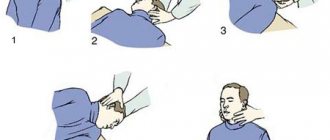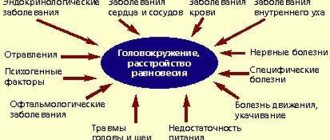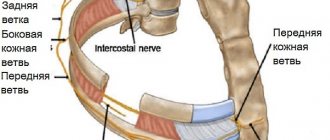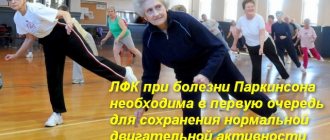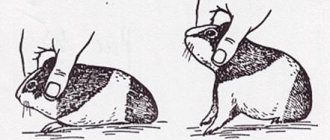IP – LYING ON YOUR BACK
- Arms extended behind the head, stretching in four counts. Repeat 6-8 times.
- Arms are extended behind the head, without lifting your hands from the floor, raise your head and look at your outstretched socks. Repeat 4-6 times
- “Bicycle” - put your hands under your head, legs bent, 3 sets for a count of 10.
- Legs bent at the knees, straighten your legs up, spread them apart, then connect them and lower them down. Repeat 6-8 times.
- Diaphragmatic breathing: inhale - inflate the stomach, exhale - draw in the stomach, 6-8 times.
IP – SITTING ON A CHAIR OR STOOL
- Arms are lowered along the body, tilt your head forward - slowly and touch your chin to your chest, and just as slowly come back. 6-8 times
- The arms are lowered along the body - we bend the arms at the elbows, move the elbows back - inhale, return to the starting position - exhale. 4-6 repetitions.
- Hands on knees, palms between legs. For 2 counts, tilt the head and torso to the left, return to the starting point, for 3-4 counts, tilt the head and torso to the right, return to the starting point. 4-6 repetitions.
- Rest – “coachman” pose: head tilted forward, hands resting loosely on knees, breathing calmly. 1-2 minutes.
Exercises
Head turns with fixed gaze
Sit in a position that is comfortable for you and fix your gaze on a stationary object (target) located approximately 1-1.5 m in front of your eyes. Turn your head in a horizontal plane from side to side, then in a vertical plane up and down, without taking your eyes off the target. In the first days of doing this exercise, try to move your head slowly and very carefully, listening to your sensations to see if dizziness occurs. In the following days, gradually increase the speed of head movement.
After 5-7 sessions (when the condition has stabilized), complicate the exercise: place the target in front of a distracting bright or moving background (for example, stick the target on the glass of a window) and perform the exercise while standing.
Eye tracking of a moving object
Sit in a position that is comfortable for you and fix your gaze on the tip of a pencil or pen, extended to the length of your arm (right). Next, with your right hand, gradually bring the pencil closer to the tip of your nose, without taking your eyes off it, and then smoothly return it back to its original position, etc.
Fix your gaze on an object (for example, a pencil) located at arm's length and turn your head from side to side in a horizontal plane. Simultaneously with the turns of the head, the object on which the gaze was fixed moves in the direction opposite to the direction of movement of the head (but you continue to follow with your eyes).
Reading
Sit in a position that is comfortable for you and take a book in front of you, placed at a distance so that you can read it. Turn your head in a horizontal plane from side to side, then in a vertical plane while reading the text of the book out loud.
Shifting the gaze and head from target to target
Place two targets (objects) in front of you at a distance of 1-1.5 m. The distance between targets is about 1 meter. First, look straight ahead. Next, look at the left target with only your eyes, fix your gaze on it, and only then turn your face to the left. Remaining in this position (face looking at the left target), move your eyes to the right target, and only after fixing your gaze, turn your face to the right towards the target. Next, move your eyes to the left target, then your face, etc.
Exercises with an object (ball, apple, etc.)
Sit on a chair, take an object (ball, apple, etc.) in your right hand. Bend over and place the object on the floor to your side, then return to the starting position. Then bend down again and take the object in your hand. Next, bend down again and put the object down again, etc.
Sit on a chair and throw objects from hand to hand above your eyes
Lean forward and transfer the ball from one hand to the other under your knees, while keeping your eyes open.
Balance exercises
Stand with your feet together and your arms extended forward. Slowly turn your head in different directions (left, right)
Stand with your feet together and your arms extended forward. Closing and opening eyes to count. For example, count one, two, three.
Standing alternately on one leg with eyes open (initially for 10 seconds, increasing to 30 seconds). You can keep your arms down or to the sides if it is difficult to maintain balance.
Stand one foot in front of the other, arms crossed at the shoulder joints, eyes open. Change position (right foot in front, then left). 10 seconds in each position.
Stand with your feet shoulder-width apart and distribute your weight evenly. Hands are relaxed. Shift your center of gravity a little forward, then a little back. Don't deviate too far. Shift your weight from side to side: first to the right, then to the left. Do not move the hip joint. Then do this exercise with your eyes closed.
IP – LYING ON YOUR Stomach
- Stretch your arms forward without lifting your chin from the floor, raise your legs, spread them, connect them, then lower them. Repeat 4-6 times.
- “Swimming” - raise your upper body and perform a movement with your arms as if swimming, without touching the floor with your hands. 4-6 repetitions of 4 movements on each hand.
- Hands in a “lock” behind your head, bend over 4-6 times.
- “Wings” - raise your arms and torso above the floor, spread your arms to the sides and swing them up and down 6 times
- Rest.
IP – SITTING ON A CHAIR OR STOOL
- Keep your head and shoulders straight. Slowly turn your head as far to the right as possible (5 times). Move to the left the same number of times.
- Lower your chin to your neck. Turn your head first 5 times to the right and then 5 times to the left.
- Throw your head back. Try to touch your right ear to your right shoulder (5 times). Perform the same movement, trying to touch your left shoulder with your left ear (5 times).
***The exercise therapy complex is designed for “dummies”, i.e.
a person who has never played sports, so it’s easy to do. First, within 2 months you must master the exercise therapy complex to the point of automatism, doing one approach of each exercise, then from the 3rd month the number of approaches can be increased to 2 for each exercise. Alternate exercises with rest, do not strain. Additional information can be obtained from our medical center.
Vestibular neuronitis
Vestibular neuronitis (VN) is an acute, most often viral lesion of the vestibular ganglion, vestibular nuclei and other retrolabyrinthine structures.
Schematic representation of vestibular nerve damage in VN
The disease occurs equally often in males and females, most often at the age of about 40 years.
Etiology and pathogenesis
VN is associated with diseases of infectious-allergic and toxic-allergic origin (herpes simplex virus type 1, food poisoning, metabolic disorders, etc.), as well as with diseases of unknown nature. The viral etiology of VN is supported by the frequent development of the disease after a respiratory viral infection, the epidemic nature of the disease with a peak incidence occurring in late spring and early summer, as well as cases described in the literature of simultaneous illness of several family members. The role of the herpes virus is confirmed by cases of the development of VL in herpetic encephalitis. The duration of clinical manifestations averages from 1 week to 3 months, after which the disease disappears without a trace and never recurs.
Clinic
Against the background of sudden severe dizziness, horizontal rotatory spontaneous nystagmus is detected, directed towards the affected ear, changing its direction to the opposite after a few hours. Dizziness usually increases with head movements and decreases with fixed gaze. Oscillopsia is often observed - unclear visual perception of surrounding objects when performing passive or active head movements due to instability of the image on the retina. Coordination of movements and balance are sharply disturbed: the patient lies on his side, corresponding to the side in which spontaneous nystagmus is directed. The vast majority of patients experience nausea (94%) and vomiting (65%). The severity of the symptoms frightens patients and their relatives so much that almost all patients with VN are taken to the hospital by an ambulance team.
Hearing does not decrease; neurological examination does not reveal symptoms indicating damage to the brain stem or other parts of the brain. The attack can last for several hours and days, then its severity gradually decreases, and usually after 10-14 days spontaneous signs of vestibular dysfunction disappear.
Diagnostics
It is based on the typical clinical picture of the disease: acute and relatively long-term (from several hours to several days) dizziness, accompanied by instability, horizontal or horizontal-rotatory spontaneous nystagmus with oscillopsia, nausea and vomiting. The diagnosis can be confirmed using a caloric test that reveals vestibular hyporeflexia or areflexia on the affected side, a head impulse test
The technique of performing the test is as follows: the patient is asked to fix his gaze on the tip of the nose of the doctor sitting opposite him, after which the doctor puts his hands on the patient’s head and with a sharp, sudden movement rotates it to the right, and then after a pause to the left by 20°. Normally, the patient's eyes remain fixed to the object of observation (the tip of the doctor's nose). If the vestibular function is impaired, the patient’s eyes turn along with the head, and then the gaze returns to the object (in this case, the patient has pathology on the left) and the Fukudo walking test.
Indirect signs of VN can be detected using high-field magnetic resonance imaging of the brain with gadolinium.
Enhanced MR signal from the left vestibular nerve in a patient with LN (contrast-enhanced MRI, gadolinium)
Treatment
The main directions of therapy for patients with VL are to reduce dizziness, nausea and vomiting and accelerate vestibular compensation. Symptomatic treatment includes the use of vestibular suppressants: dimenhydrinate (Dramine), metoclopramide (Cerucal), benzodiazepine tranquilizers (Diazepam) or phenothiazines (thiethylperazine). For vomiting, use the parenteral route of drug administration. Vestibular suppressants are recommended to be used for no more than 3 days, as they slow down vestibular compensation. It has been established that in patients with VL, the use of methylprednisolone in the first three days of the disease (at an initial dose of 100 mg, followed by a dose reduction by 20 mg every three days) leads to a higher rate of restoration of vestibular function a year after the disease.
It is also recommended to conduct vestibular gymnastics, which includes exercises in which movements of the eyes, head and torso lead to sensory mismatch.
Exercises for vestibular rehabilitation (Cawthorne-Cooksey, 1940)
To accelerate vestibular compensation in combination with vestibular gymnastics, betahistine can be used up to 48 mg/day for 1 month or more. The use of neuromidin according to the regimen of 20 mg 3 times a day for two months is also pathogenetically justified.
← Back
